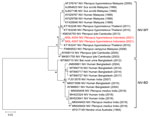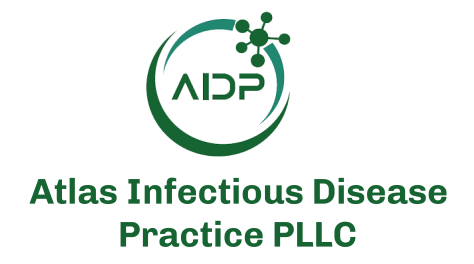Disclaimer: Early release articles are not considered as final versions. Any changes will be reflected in the online version in the month the article is officially released.
Author affiliation: Environmental Health National Referral Laboratory, Directorate General of Public Health, Ministry of Health of the Republic of Indonesia, Salatiga, Indonesia (D.B.W. Putro, E. Rahardianingtyas, A. Ardanto, A.S. Joharina, T.V. Sari); National Research and Innovation Agency, Bogor, Indonesia (A. Mulyono, M.C. Hidajat, Y.M. Anggraeni, Ristiyanto, N.L.P.I. Dharmayanti, T.A. Garjito, R.T. Sasmono)
Nipah virus, a zoonotic RNA virus member of the genus Henipavirus, can cause lethal encephalitis in humans and has an average case-fatality rate of 61.08% (1). The 18.2-kb Nipah virus genome encodes 6 structural proteins (N, P, M, F, G, and L) and 3 nonstructural proteins (C, V, and W) (2). Nipah virus has 2 genotypes; Malaysia genotype is associated with outbreaks in Southeast Asia, and Bangladesh genotype is prevalent in Bangladesh and India. The 2 genotypes exhibit different transmission dynamics and mortality rates (3).
In 1998, a Nipah virus outbreak in Malaysia affected 265 persons, leading to 105 deaths; another outbreak in Singapore in 1999 had 11 cases and 1 death. Pigs (Sus domesticus) were the intermediate hosts for both outbreaks (3,4). In 2014, the Philippines experienced an outbreak involving horses (Equus caballus) as intermediate hosts, and human-to-human transmission occurred (3,4). South Asia has faced recurring outbreaks since 2001, predominantly in Bangladesh and India. In those regions, virus transmission is primarily bat-mediated; Pteropus bats serve as natural reservoirs, and human-to-human transmission is also prevalent (3,5).
Pteropus spp. bats are natural hosts of Nipah virus and harbor the virus in saliva, urine, semen, and feces without showing symptoms. The bats are widely distributed in Asia, including Indonesia (3). Although no human Nipah virus cases have been reported in Indonesia, its geographic proximity to outbreak regions such as Malaysia and Singapore (4) (Appendix Figure) and the widespread presence of Pteropus spp. bats (6) pose major risks. To assess Nipah virus prevalence, we conducted molecular screening in wild-caught bats in Central Java, Indonesia.
The Health Research Ethics Committee, National Institute of Health Research and Development, Jakarta, Indonesia, approved this study (approval no. LB.02.01/2/KE.691/2021). We collected bats from animal markets in Yogyakarta City and Magelang Regency, Central Java, Indonesia (Appendix Figure), during September 2021 and handled the specimens under strict biosafety protocols in an enhanced Biosafety Level 2+ facility. We collected rectal swab specimens by using the BD universal viral transport system (BD, https://www.bd.com). Morphologic observations and morphometric measurements provided bat identification, as described previously (7). For Nipah virus detection, we extracted RNA from rectal swabs by using the RNeasy Mini kit (QIAGEN, https://www.qiagen.com). We conducted reverse transcription PCR (RT-PCR) targeting the nucleocapsid (N) gene, as described previously (8). We amplified the gene by heminested PCR using the SuperScript III One-Step RT-PCR kit (Thermo Fisher Scientific, https://www.thermofisher.com). We purified PCR products and sequenced by using the BigDye Terminator v3.1 Kit on a 3500 Genetic Analyzer (Thermo Fisher Scientific). We performed phylogenetic analysis using MEGA 11 software (http://www.megasoftware.net) with a maximum-likelihood algorithm (Appendix).
We obtained 64 fruit bats from traders at animal markets: 37 in Yogyakarta and 27 in Magelang (Figure 1, panels A, B; Appendix). Morphologic identification confirmed all bats as P. hypomelanus species (Figure 1, panel B; Appendix Tables 1, 2). RT-PCR of 64 samples detected 2 positive bats from Magelang, Central Java. Sanger sequencing of the N gene confirmed the results and yielded 400-bp and 398-bp sequences. We deposited both sequences in GenBank (accession nos. PQ684035 and PQ684036).
Phylogenetic analysis showed that the isolated Nipah virus in this study belonged to the Malaysia genotype and was closely related to Nipah virus from P. lylei bats in Cambodia (99.25% homology with GenBank accession no. KM034755), P. hypomelanus bats in Thailand (98.99% homology with GenBank accession no. KT163249), and an isolate from Malaysia (98.74% homology with GenBank accession no. AY029768) (Figure 2). Those findings suggest a strong genetic relationship in Nipah virus in Southeast Asia and indicate regional transmission. The 2 Nipah virus isolates from Indonesia are similar, suggesting local transmission among bats and establishing that viral strain in Indonesia.
Nipah virus detection in P. hypomelanus bats on the densely populated Java Island represents expansion of the known distribution of that pathogen. Although Indonesia has not experienced Nipah virus outbreaks, Nipah virus has been detected in P. vampirus bats in Sumatra Island (9). That expanding geographic range confirmed the presence of Nipah virus in various Pteropus bats (3). Of note, P. hypomelanus bats exhibit the broadest distribution in Indonesia (6) and are frequently hunted and traded, potentially increasing human–bat interactions and risk for zoonotic transmission. Crowded animal markets with poor sanitation amplify that risk because of virus spillover to humans and domestic animals, as in our study sites.
This study underscores the importance of molecular surveillance of Nipah virus in wildlife reservoirs and humans to identify high-risk areas and transmission pathways. The One Health approach, integrating human, animal, and environmental health, offers a framework for addressing challenges, such as limited surveillance and complex transmission dynamics. By combining data across sectors, stakeholders can enhance their ability to predict and mitigate potential outbreaks (10).
In conclusion, our study confirms the detection of Nipah virus in P. hypomelanus fruit bats collected from animal markets in Central Java, Indonesia, and provides insight into virus distribution and transmission in the country. Comprehensive surveillance of animal reservoirs is necessary to mitigate human transmission risks and prevent future outbreaks.
Dr. Putro is a field veterinary epidemiologist at the Environmental Health National Referral Laboratory, Directorate General of Public Health, Ministry of Health of the Republic of Indonesia. His research interests include the epidemiology of emerging viruses from animal reservoirs.
We acknowledge all virology and disease reservoir laboratory teams at the Environmental Health National Referral Laboratory, Directorate General of Public Health, Ministry of Health of Indonesia, and Human-Animal Interface laboratory teams, National Research and Innovation Agency Indonesia. We thank Bunga Rana for sequence data management. We also thank the people and bat traders at the study sites for cooperating during the bat surveys and collection.
This study was funded by the National Institute of Health Research and Development, the Ministry of Health of Indonesia in the fiscal year 2021.
Author contributions: D.B.W.P., A.M., E.R., A.S.J. and R. conceived and designed the experiments. D.B.W.P., A.M., E.R., A.S.J., A.W. M.C.H., Y.M.A., and R. performed field sampling and experiments. D.B.W.P., A.M., T.A.G., N.L.P.I.D., and R.T.S. analyzed the data. D.B.W.P., A.M., T.A.G., M.C.H., and R.T.S. wrote the manuscript.








